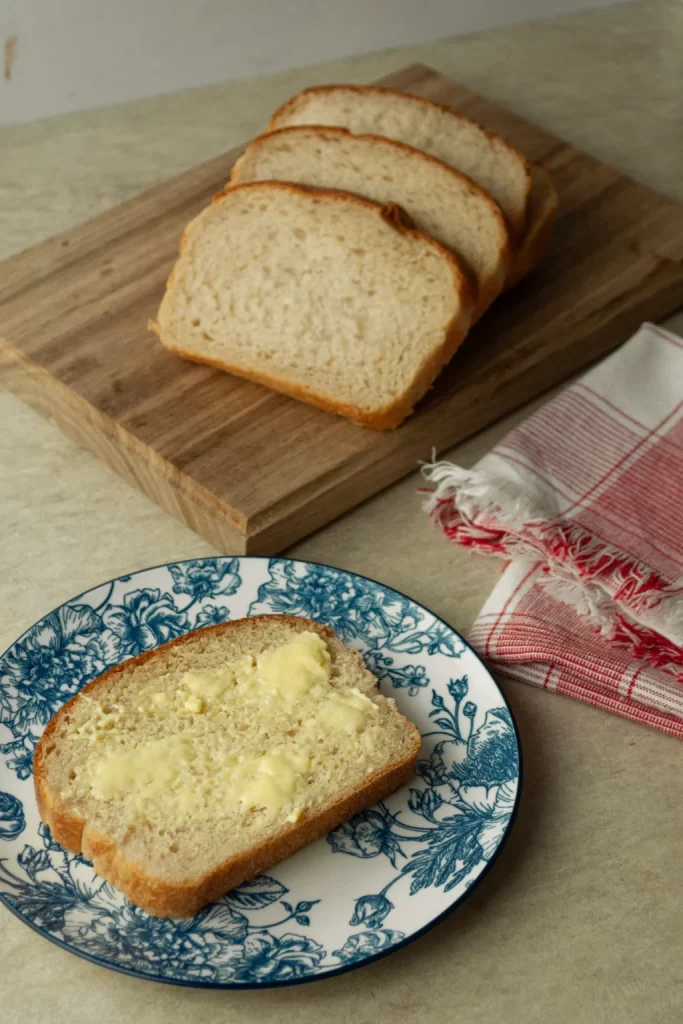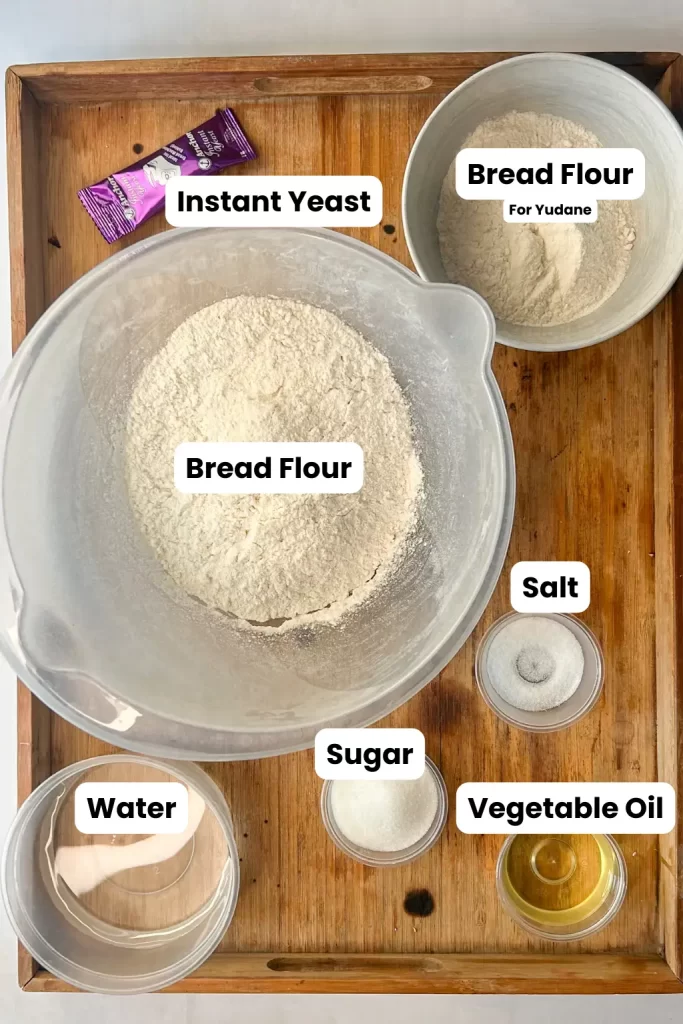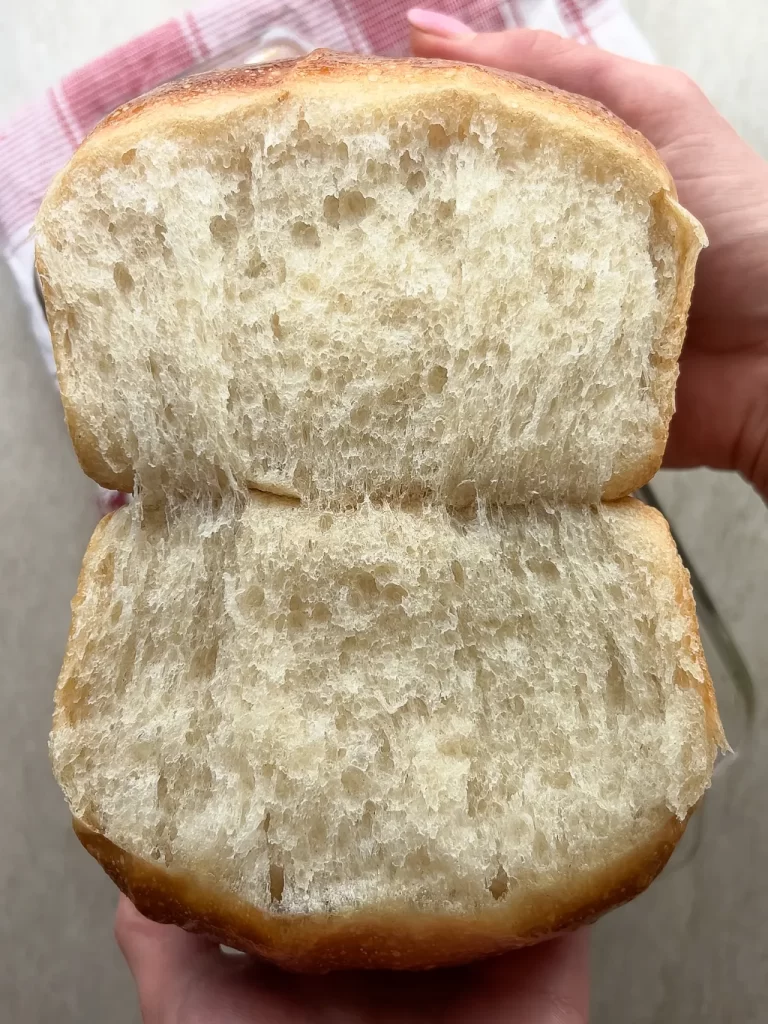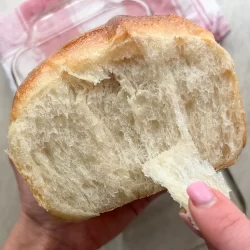You’ve just found the ultimate vegan sandwich bread recipe—soft, fluffy, and completely dairy-free. Adapted from the wonderful Dairy-Free Bread Recipe by Merry Boosters, I’ve made a few tweaks, including the addition of the Yudane technique, to make the loaf even softer, more tender and last longer. This recipe is perfect for anyone looking to bake a delicious, homemade loaf.

You can stop your search for the perfect vegan sandwich bread recipe. Why, you ask? Because you’ve found it!
If you’re after a loaf that’s incredibly soft and fluffy with a tender crumb that practically melts in your mouth, you’re in for a treat! This bread is not just simple to make, but it’s also incredibly satisfying.
When I set out to create the best vegan sandwich bread, I knew it wouldn’t be easy. But I wasn’t about to give up. My goal was crystal clear: to craft a recipe that anyone could follow, from seasoned bakers to complete beginners.
And I didn’t stop there. I know how important it is to use ingredients you can actually find in your pantry. So, I made sure this bread comes together with everyday staples — no fancy ingredients needed!
One of the joys of making your own bread at home is the control you have over every ingredient. You know exactly what goes into your loaf—no preservatives, no artificial additives—just pure, wholesome ingredients. Plus, there’s nothing quite like the smell of freshly baked bread filling your kitchen!
Why You’ll Love This Recipe
- Soft and Fluffy Texture: This bread has an unbelievably soft and fluffy crumb, reminiscent of Japanese milk bread, but it’s entirely dairy-free. No milk, no butter, no eggs—just pure, pillowy goodness.
- Versatile Preparation: Whether you’ve got a stand mixer or just your trusty hands, this dough is a breeze to work with. It’s not overly sticky, making it accessible for any home baker.
- Great for everyone: This vegan sandwich bread isn’t just for those following a plant-based diet—it’s a great addition to any kitchen. Whether you’re making a hearty sandwich for lunch, a slice of toast with your breakfast, or just enjoying a warm slice straight from the oven, this bread is versatile and universally loved.
- Simple Ingredients, Amazing Results: With just a few basic pantry staples, you can create a loaf that rivals anything from a bakery. The secret? The Yudane technique, which involves gelatinizing some of the flour with boiling water. This locks in moisture and gives this vegan sandwich bread recipe its characteristic softness.
Ingredients and Substitutions

Grab all your ingredients! View the recipe card below for a full list of all the ingredients and measurements.
For the Yudane (Dough Conditioner):
- White bread flour: This forms the base of the Yudane, which is key to achieving that super soft, fluffy texture.
- Boiling water: This is what transforms the flour into a thick paste, helping to lock in moisture and keep your bread tender.
For the Main Dough:
- White bread flour: The backbone of your bread, providing the structure needed for a perfect loaf.
- Water: Keeps things dairy-free while ensuring your bread stays moist and soft.
- Vegetable oil (canola): Adds moisture and richness to the dough.
- Substitution: Olive oil works great for a slight flavour twist, or you could try coconut oil—just keep in mind that because it’s solid at room temperature, it might not yield as soft a loaf.
- Granulated sugar: Adds just the right amount of sweetness without overpowering the flavour.
- Substitution: Swap in brown sugar or coconut sugar for a different flavour profile.
- Salt: Essential for enhancing the flavour.
- Instant yeast: The secret to a well-risen, fluffy loaf.
- Variation: I almost always make this loaf with Sourdough starter instead of instant yeast, but I wanted it to be accessible for everyone so I have the instant yeast version as the primary recipe. You can review the recipe notes to see how much starter to incorporate and how to reduce the water and flour accordingly. If you want to learn to make your own sourdough starter and bake your first loaf – I have a free guide on just that.
Ready to bake? This vegan sandwich bread recipe is your go-to for a soft, fluffy loaf that everyone will love. Give it a try and share your results!


Softest Vegan Sandwich Bread Recipe (Dairy-Free, No Butter, No Milk)
Equipment
- 1 loaf tin 23 x 13 x 6 cm
Ingredients
For the Yudane (dough conditioner)
- 66 g white bread flour about 1/2 cup + 1 tbsp
- 66 g boiling water about 1/4 cup + 1 tbsp
For the main dough
- 356g g white bread flour 2 3/4 cups
- 210 g water 7/8 cup (just under a cup)
- 40 g granulated sugar about 3 tbsp + 1 tsp
- 46 g vegetable oil (sunflower/canola) about 3 tbsp + 1 tsp
- 7 g salt about 1 1/4 tsp
- 7 g instant yeast 1 packet
Instructions
For the Yudane (Dough Conditioner):
- In a small bowl, combine the white bread flour with boiling water.66 g white bread flour, 66 g boiling water
- Stir until a thick paste forms. It's fine if it's a little clumpy.
- Set the Yudane aside to cool for about 20-30 minutes.
For the Main Dough:
- In a large mixing bowl, whisk together the water, vegetable oil, sugar, salt and instant yeast until well combined.
- Add the white bread flour to the bowl, mixing with a wooden spoon or the stand mixer on low speed until a dough forms and there are no dry spots.
- Cover the dough in plastic or a damp cloth and let it rest for 20 minutes (this is the autolyse period, which helps the flour fully hydrate and begin gluten development).
- After the 20-minute autolyse, add the cooled Yudane mixture and knead for 10-12 minutes by hand or 8-10 minutes in the mixer until the dough is smooth and elastic. If the dough sticks to your hands, lightly oil your hands when kneading.
- The dough should pass the windowpane test: stretch a small piece of dough until it’s thin enough to let light through without tearing. If it tears before it's thin enough, knead or mix for a few more minutes and test again.
- Place the dough in a lightly oiled bowl, cover with plastic or a damp cloth, and let it proof in a warm place (24-28°C) until doubled in size, about 1 hour.
- Poke Test: After the dough has been proofing, gently press a finger into the dough about 2 cm deep. If the indentation does not spring back, or only partially springs back slowly, the dough has risen enough. If the dough springs back quickly and fully, allow it to proof longer.
Shaping and Proofing:
- Grease a 23 x 13 x 6 cm loaf pan.
- Once the dough has doubled in size, turn it out onto a lightly oiled surface.
- Roll it out with a rolling pin into a log shape and pinch the ends to seal it.
- Place the rolled dough into the greased loaf pan. Cover with plastic or a damp cloth and let it proof for another 70-75 minutes in a warm place (time will differ based on temperature), until the dough is about 2 cm above the rim of the pan.
Baking:
- Preheat your oven to 190°C (350°F).
- Spray or brush the top of your loaf with a little bit of water. You can also use a dairy-free milk or egg wash if you want a shinier loaf.
- Bake the loaf at 190°C for 30-35 minutes until the top of the bread is golden brown. To add a little steam and prevent the load from cracking, you can add a baking sheet to the bottom of the oven and throw in 2-3 ice cubes (optional).
- Remove the bread from the loaf pan and cool on a wire rack for at least 30 minutes before slicing. Enjoy warm or at room temperature.
- Storage:
- – Store in a large bread bag on the counter. Best enjoyed within 2-3 days.
- – This loaf freezes very well so you can slice it and store in a large freezer bag.
Notes
- Measure your sourdough starter in grams (e.g., 70g).
- Divide that amount by 2 (e.g., 70g ÷ 2 = 35g).
- Subtract the result from both the flour and water amounts in the recipe:
- For flour: Subtract the result from the total flour (e.g., 356g – 35g = 321g).
- For water: Subtract the result from the total water (e.g., 210g – 35g = 175g).
- Add the sourdough starter to the bowl first, then your water, sugar, yeast and whisk to combine.
- Add flour and salt (don’t put salt on top of the starter)
- Follow the rest of the recipe as described.
Frequently Asked Questions
Can I make this vegan sandwich bread recipe gluten-free?
Unfortunately, this vegan sandwich bread recipe relies on the gluten in bread flour to give it that soft, fluffy texture. A direct gluten-free substitution won’t work quite the same way. However, you could experiment with a gluten-free bread flour blend if you’re feeling adventurous—just keep in mind the texture will be different.
How do I store this vegan sandwich bread?
To keep your bread fresh and soft, wrap it tightly in plastic wrap or store it in an airtight container. It should stay soft for 2-3 days. However, it also freezes extremely well! Slice it up before freezing so you can easily grab a piece whenever you’re in the mood for some homemade goodness.
Why is my bread dense?
A dense loaf can be a result of under-kneading, underproofing the dough or using old yeast. Make sure your yeast is fresh and knead the dough until it passes the windowpane test (stretching a piece of dough until it’s thin enough to let light through without tearing). To prevent underproofing, ensure your dough rises about 2cm above the pan before baking to ensure it’s fully proofed. This will help ensure a light, airy texture.
What’s the best way to serve this vegan sandwich bread?
This vegan sandwich bread recipe is incredibly versatile! It’s perfect for sandwiches—whether you’re keeping it simple with peanut butter and jam or going gourmet with avocado and smoked salmon/tofu. It’s also great toasted with a spread of your favourite butter or jam.

